Unit 2 Travelling Around Reading and Thinking 课件(共27张PPT) 人教版(2019)必修第一册
文档属性
| 名称 | Unit 2 Travelling Around Reading and Thinking 课件(共27张PPT) 人教版(2019)必修第一册 | 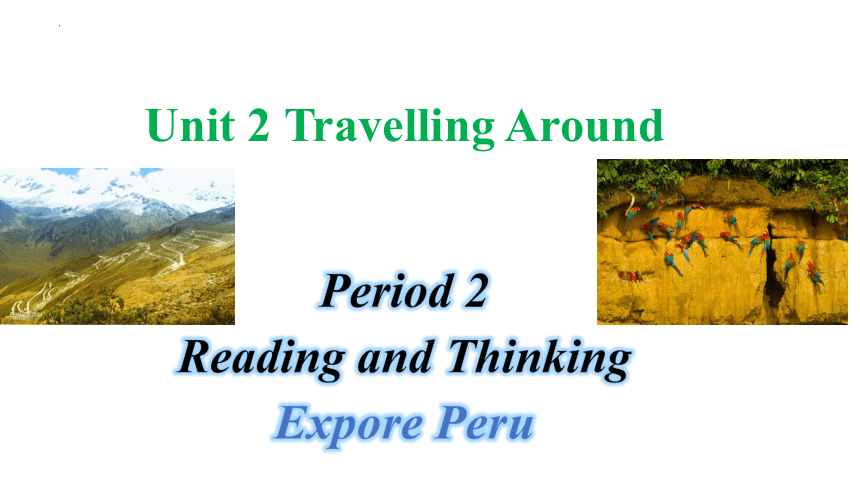 | |
| 格式 | pptx | ||
| 文件大小 | 24.5MB | ||
| 资源类型 | 教案 | ||
| 版本资源 | 人教版(2019) | ||
| 科目 | 英语 | ||
| 更新时间 | 2024-10-10 20:06:35 | ||
图片预览

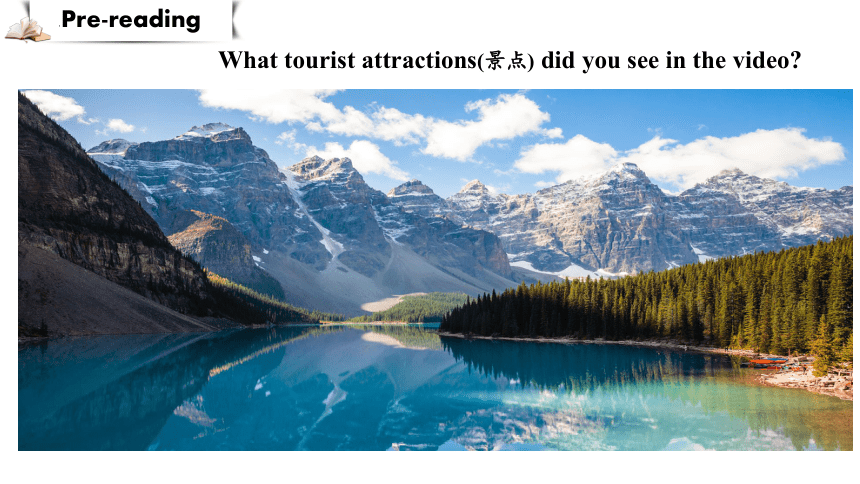
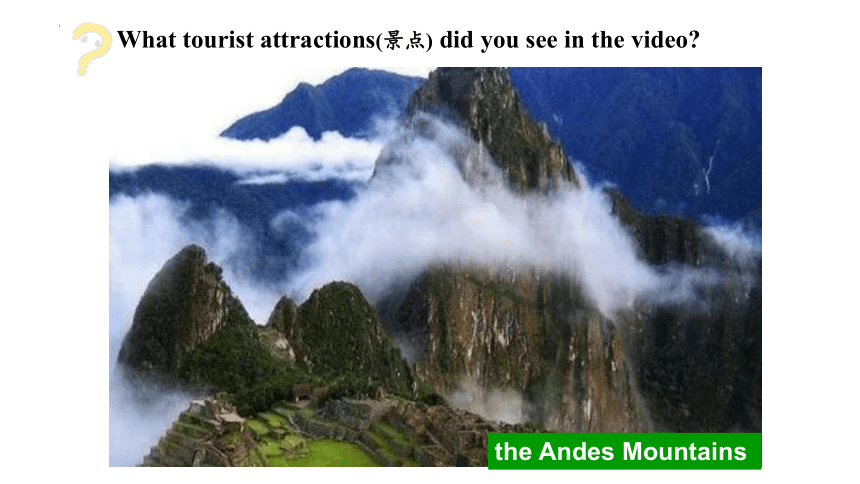
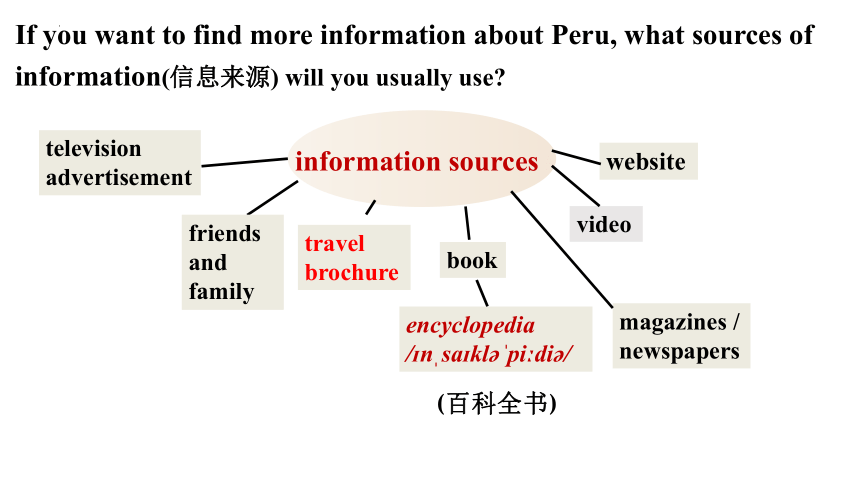
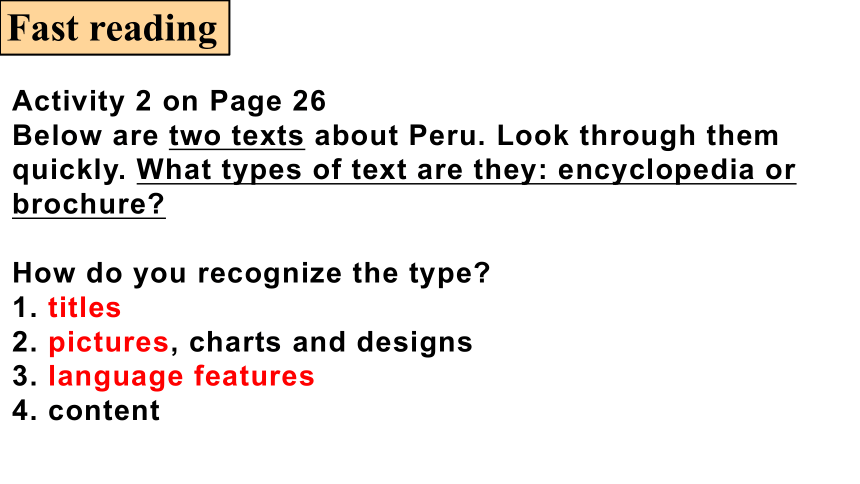
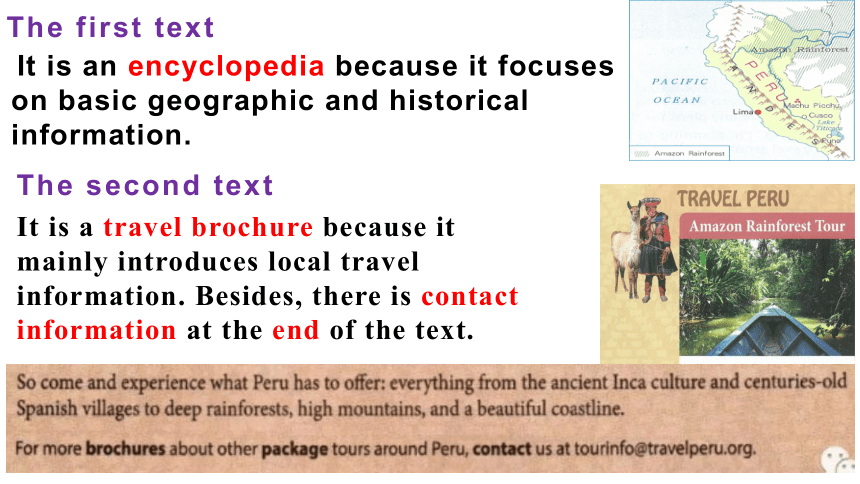
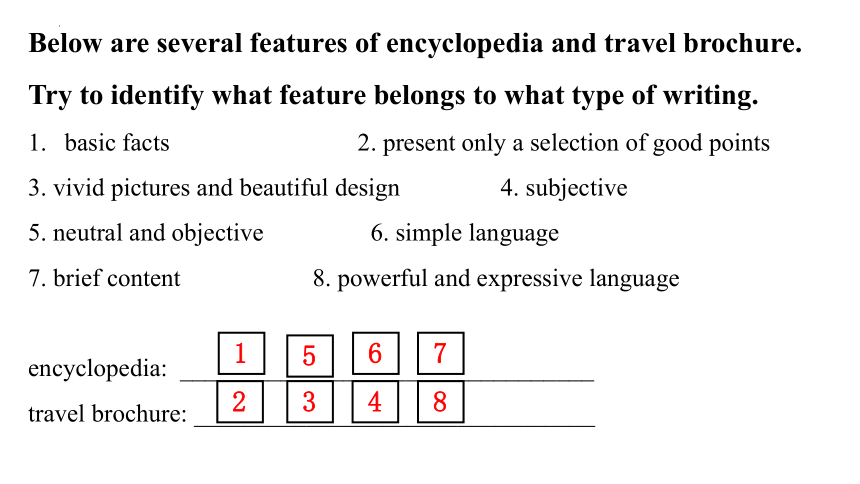
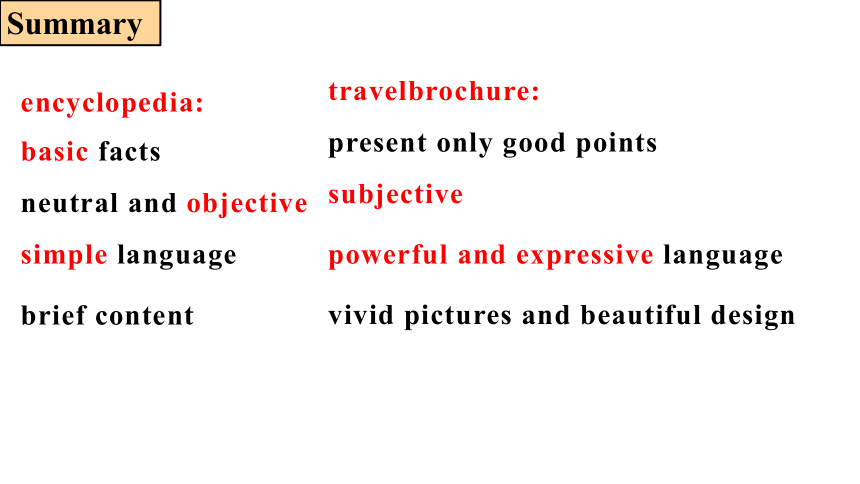
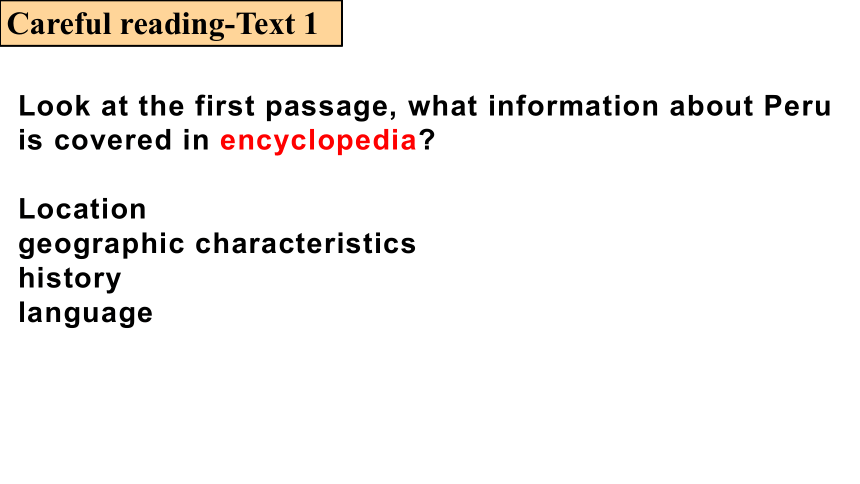
内容文字预览
(共27张PPT)
Unit 2 Travelling Around
Period 2
Reading and Thinking
Expore Peru
Pre-reading
What tourist attractions(景点) did you see in the video
Cusco
Amazon Rainforest
Machu Picchu
Lake Titicaca
What tourist attractions(景点) did you see in the video
the Andes Mountains
information sources
encyclopedia
/ n sa kl pi di /
book
travel brochure
website
magazines /
newspapers
video
friends and family
(百科全书)
television
advertisement
If you want to find more information about Peru, what sources of
information(信息来源) will you usually use
Fast reading
Activity 2 on Page 26
Below are two texts about Peru. Look through them quickly. What types of text are they: encyclopedia or brochure
How do you recognize the type
1. titles
2. pictures, charts and designs
3. language features
4. content
The first text
The second text
It is an encyclopedia because it focuses on basic geographic and historical information.
It is a travel brochure because it mainly introduces local travel information. Besides, there is contact information at the end of the text.
Below are several features of encyclopedia and travel brochure. Try to identify what feature belongs to what type of writing.
basic facts 2. present only a selection of good points
3. vivid pictures and beautiful design 4. subjective
5. neutral and objective 6. simple language
7. brief content 8. powerful and expressive language
encyclopedia: _________________________________
travel brochure: ________________________________
1
2
3
4
5
6
7
8
encyclopedia:
basic facts neutral and objective simple language
brief content
travelbrochure:
present only good points
subjective
powerful and expressive language
vivid pictures and beautiful design
Summary
Look at the first passage, what information about Peru is covered in encyclopedia
Location
geographic characteristics
history
language
Careful reading-Text 1
What information can we get from a travel brochure
number of days
transports
accommodation
activity
cost
weather
Careful reading-Text 2
Post reading
Supoose you are a guide, choose one of the tour routes in text 2 to introduce it to your visitors.
CUSCO is ____ of the most popular destinations for tourists, because of its unique place_____ the history of South America.Cusco was the capital of the city of the Inca Empire,________was the most powerful empire in South American until 1500s. There were two _________(especial) interesting things _______ (admire)about the Inca Empire.The first is the roads and _______(path)they _______(build) to connect their important cities.
one
in
which
especially
paths
to admire
built
Summary
These Inca roads were made up of two north-south highways and many small roads _________(cross) the mountains east to west. The roads were for Inca soldiers and their officials. Second, the Inca constructed wonderful cities full of _______ (amaze) architecture—_______ there were no markets in these cities. One of the interesting questions of history is how the Incas lived without shopping!
crossing
amazing
but
Language Points
I met Li Hua at the hospital yesterday.
强调主语_________________________________
强调宾语_________________________________
_________________________________
强调地点状语_____________________________
强调时间状语_____________________________
It was I that/ who met Li Hua at the hospital yesterday.
It was at the hospital that I met Li Hua yesterday.
It was yesterday that I met Li Hua at the hospital.
It was Li Hua that/ whom I met at the hospital yesterday.
强调句
注意
强调句结构:
翻译:
强调状语时,只能用that而不能用where/ when/ why等;强调人时,可以用that/ who/ whom。
4) 原句的时态是一般过去时、过去进行时、过去完成时时,用“It was …”;其他时态用“It is…”。
5) 强调句型的判断:去掉It is / was 与 that/ who 后,剩余部分若结构完整、句意明确,则为强调句,否则不是。
“正是…;就是…
It is + 被强调的部分+that/who +句子剩余部分
6) Was it on the street that you met him
Where was it that you met him
强调句的一般疑问句
强调句的特殊疑问句
单句语法填空
(1)It was because of the bad weather __ the football match was put off.
(2)It was last night _______ I met Mary on my way to school.
(3) _____ is not who is right but what is right than is of great importance.
考察方式
that
that
It
2.You can spend the three days exploring the rainforest with a local guide and enjoying the plants and animals unique to the rainforest.
翻译:
在接下来的三天里,您可以在当地导游的陪同下,深入雨林进行探索,欣赏雨林特有的动植物。
形容词短语用作后置定语,修饰前面的名词。
(be) unique to sb./sth. (某人、地或事物)是独具的、特有的
形容词短语作后置定语
She doesn’t have any shoes ________(suit) for the wedding.
suitable
2. Especially amazing is the Incas’ dry atone method of building.
【翻译】
特别令人惊叹的是印加人的用干燥的石头搭砌的建造方法。
分析】本句为完全倒装句。因语篇衔接和寓意需要而使用了倒装。表语especially amazing 前置是为了表示突出和强调,正常的语序应为“The Incas’ dry stone method of building is especially amazing.”。
把倒装还原成正常语序:
1.Seated in the first row are some advanced workers.
2.Present at the meeting were some scientists from China.
倒装
单句填空:
1.Gone ____ (be) the days when my heart was young and gay.
2.Among them _______ (be) a soldier who was wounded
in the stomach.
3.East of the city _______(lie) a big factory.
are
was
lies
考察方式
with 复合结构
Peru is a country on the Pacific coast of South America with three main areas: narrow, dry, flat land ________(run) along the coast.
The students are listening to the teacher with their eyes looking at the blackboard.
With his hair cut, he looked much younger.
With a lot of work to do, he wasn’t allowed to go out.
The old man fell asleep with the light on.
On Christmas Eve, a poor little girl was wandering in the street with her feet bare.
running
总结:with + 名词 +其他成分
思考:名词作什么成分,其他成分修饰谁?
with + 宾语(名词) +
形容词
副词
名词
介词短语
v-ing
v-ed
to do
主动、进行
被动、完成
将要发生(主动形式表被动意义)
表示状态
with复合结构的构成:with +宾语+宾补
注意: with结构不是句子, 它在句中作 定语或状语,故with结构中不会有谓语动词形式。
考点:With +名词+非谓语
1.He used to sleep with all the windows open.
2.With the meal over, we all went home.
3.A man broke in, with a knife in his hand.
4.You mustn’t talk with a person with your finger pointing at her.
5.He lay on his back , with his hands crossed under his head.
6.With the new term to begin soon, we’ll be very busy again.
with +宾语+形容词
with+ 宾语+副词
with+宾语+介词短语
with +宾语+现在分词
with+宾语+过去分词
with+宾语+不定式
考察方式
1. She left with the child ______(cry).
2. She left with her wallet ________(steal).
3. With the key______(lose), she could not enter the room.
4. With time _________(permit), we will visit the Summer Palace.
5. With winter_______(come), the trees turn yellow.
6. With a lot of work _______(do), she doesn't have time to rest.
7. With the work _____(do), he left early today.
8. With our problem_______(settle), we all felt happy.
9. I sat in my room for a few minutes with my eyes______(fix) on the ceiling.
crying
stolen
lost
permitting
coming
to do
done
settled
fixed
These Inca roads were made up of two north-south highways and many small roads _______(cross) the mountains east to west.
Enjoy the beautiful countryside as you spend a day driving along the new highway _________(connect) Cusco to Lake Titicaca.
Don’t wake up the sleeping kid.
The man talking with out headmaster is Tom’s father.
The problem discussed yesterday at the meeting was very important.
The man to help us is John.
定义:单个的非谓语动词作定语时,通常放在被修饰的词之前。非谓语动词的短语作定语时,通常放在被修饰词的后面。
crossing
非谓语动词修饰名词作后置定语
connecting
考察方式
Last night, there were millions of people ______(enjoy) the opening ceremony live on TV.
Do you know the woman ______(sit) beside the magician _____(name) Liu Qian.
I was watching the clock all through the meeting, as I had a train _____(catch).
enjoying
sitting
named
to catch
Unit 2 Travelling Around
Period 2
Reading and Thinking
Expore Peru
Pre-reading
What tourist attractions(景点) did you see in the video
Cusco
Amazon Rainforest
Machu Picchu
Lake Titicaca
What tourist attractions(景点) did you see in the video
the Andes Mountains
information sources
encyclopedia
/ n sa kl pi di /
book
travel brochure
website
magazines /
newspapers
video
friends and family
(百科全书)
television
advertisement
If you want to find more information about Peru, what sources of
information(信息来源) will you usually use
Fast reading
Activity 2 on Page 26
Below are two texts about Peru. Look through them quickly. What types of text are they: encyclopedia or brochure
How do you recognize the type
1. titles
2. pictures, charts and designs
3. language features
4. content
The first text
The second text
It is an encyclopedia because it focuses on basic geographic and historical information.
It is a travel brochure because it mainly introduces local travel information. Besides, there is contact information at the end of the text.
Below are several features of encyclopedia and travel brochure. Try to identify what feature belongs to what type of writing.
basic facts 2. present only a selection of good points
3. vivid pictures and beautiful design 4. subjective
5. neutral and objective 6. simple language
7. brief content 8. powerful and expressive language
encyclopedia: _________________________________
travel brochure: ________________________________
1
2
3
4
5
6
7
8
encyclopedia:
basic facts neutral and objective simple language
brief content
travelbrochure:
present only good points
subjective
powerful and expressive language
vivid pictures and beautiful design
Summary
Look at the first passage, what information about Peru is covered in encyclopedia
Location
geographic characteristics
history
language
Careful reading-Text 1
What information can we get from a travel brochure
number of days
transports
accommodation
activity
cost
weather
Careful reading-Text 2
Post reading
Supoose you are a guide, choose one of the tour routes in text 2 to introduce it to your visitors.
CUSCO is ____ of the most popular destinations for tourists, because of its unique place_____ the history of South America.Cusco was the capital of the city of the Inca Empire,________was the most powerful empire in South American until 1500s. There were two _________(especial) interesting things _______ (admire)about the Inca Empire.The first is the roads and _______(path)they _______(build) to connect their important cities.
one
in
which
especially
paths
to admire
built
Summary
These Inca roads were made up of two north-south highways and many small roads _________(cross) the mountains east to west. The roads were for Inca soldiers and their officials. Second, the Inca constructed wonderful cities full of _______ (amaze) architecture—_______ there were no markets in these cities. One of the interesting questions of history is how the Incas lived without shopping!
crossing
amazing
but
Language Points
I met Li Hua at the hospital yesterday.
强调主语_________________________________
强调宾语_________________________________
_________________________________
强调地点状语_____________________________
强调时间状语_____________________________
It was I that/ who met Li Hua at the hospital yesterday.
It was at the hospital that I met Li Hua yesterday.
It was yesterday that I met Li Hua at the hospital.
It was Li Hua that/ whom I met at the hospital yesterday.
强调句
注意
强调句结构:
翻译:
强调状语时,只能用that而不能用where/ when/ why等;强调人时,可以用that/ who/ whom。
4) 原句的时态是一般过去时、过去进行时、过去完成时时,用“It was …”;其他时态用“It is…”。
5) 强调句型的判断:去掉It is / was 与 that/ who 后,剩余部分若结构完整、句意明确,则为强调句,否则不是。
“正是…;就是…
It is + 被强调的部分+that/who +句子剩余部分
6) Was it on the street that you met him
Where was it that you met him
强调句的一般疑问句
强调句的特殊疑问句
单句语法填空
(1)It was because of the bad weather __ the football match was put off.
(2)It was last night _______ I met Mary on my way to school.
(3) _____ is not who is right but what is right than is of great importance.
考察方式
that
that
It
2.You can spend the three days exploring the rainforest with a local guide and enjoying the plants and animals unique to the rainforest.
翻译:
在接下来的三天里,您可以在当地导游的陪同下,深入雨林进行探索,欣赏雨林特有的动植物。
形容词短语用作后置定语,修饰前面的名词。
(be) unique to sb./sth. (某人、地或事物)是独具的、特有的
形容词短语作后置定语
She doesn’t have any shoes ________(suit) for the wedding.
suitable
2. Especially amazing is the Incas’ dry atone method of building.
【翻译】
特别令人惊叹的是印加人的用干燥的石头搭砌的建造方法。
分析】本句为完全倒装句。因语篇衔接和寓意需要而使用了倒装。表语especially amazing 前置是为了表示突出和强调,正常的语序应为“The Incas’ dry stone method of building is especially amazing.”。
把倒装还原成正常语序:
1.Seated in the first row are some advanced workers.
2.Present at the meeting were some scientists from China.
倒装
单句填空:
1.Gone ____ (be) the days when my heart was young and gay.
2.Among them _______ (be) a soldier who was wounded
in the stomach.
3.East of the city _______(lie) a big factory.
are
was
lies
考察方式
with 复合结构
Peru is a country on the Pacific coast of South America with three main areas: narrow, dry, flat land ________(run) along the coast.
The students are listening to the teacher with their eyes looking at the blackboard.
With his hair cut, he looked much younger.
With a lot of work to do, he wasn’t allowed to go out.
The old man fell asleep with the light on.
On Christmas Eve, a poor little girl was wandering in the street with her feet bare.
running
总结:with + 名词 +其他成分
思考:名词作什么成分,其他成分修饰谁?
with + 宾语(名词) +
形容词
副词
名词
介词短语
v-ing
v-ed
to do
主动、进行
被动、完成
将要发生(主动形式表被动意义)
表示状态
with复合结构的构成:with +宾语+宾补
注意: with结构不是句子, 它在句中作 定语或状语,故with结构中不会有谓语动词形式。
考点:With +名词+非谓语
1.He used to sleep with all the windows open.
2.With the meal over, we all went home.
3.A man broke in, with a knife in his hand.
4.You mustn’t talk with a person with your finger pointing at her.
5.He lay on his back , with his hands crossed under his head.
6.With the new term to begin soon, we’ll be very busy again.
with +宾语+形容词
with+ 宾语+副词
with+宾语+介词短语
with +宾语+现在分词
with+宾语+过去分词
with+宾语+不定式
考察方式
1. She left with the child ______(cry).
2. She left with her wallet ________(steal).
3. With the key______(lose), she could not enter the room.
4. With time _________(permit), we will visit the Summer Palace.
5. With winter_______(come), the trees turn yellow.
6. With a lot of work _______(do), she doesn't have time to rest.
7. With the work _____(do), he left early today.
8. With our problem_______(settle), we all felt happy.
9. I sat in my room for a few minutes with my eyes______(fix) on the ceiling.
crying
stolen
lost
permitting
coming
to do
done
settled
fixed
These Inca roads were made up of two north-south highways and many small roads _______(cross) the mountains east to west.
Enjoy the beautiful countryside as you spend a day driving along the new highway _________(connect) Cusco to Lake Titicaca.
Don’t wake up the sleeping kid.
The man talking with out headmaster is Tom’s father.
The problem discussed yesterday at the meeting was very important.
The man to help us is John.
定义:单个的非谓语动词作定语时,通常放在被修饰的词之前。非谓语动词的短语作定语时,通常放在被修饰词的后面。
crossing
非谓语动词修饰名词作后置定语
connecting
考察方式
Last night, there were millions of people ______(enjoy) the opening ceremony live on TV.
Do you know the woman ______(sit) beside the magician _____(name) Liu Qian.
I was watching the clock all through the meeting, as I had a train _____(catch).
enjoying
sitting
named
to catch
